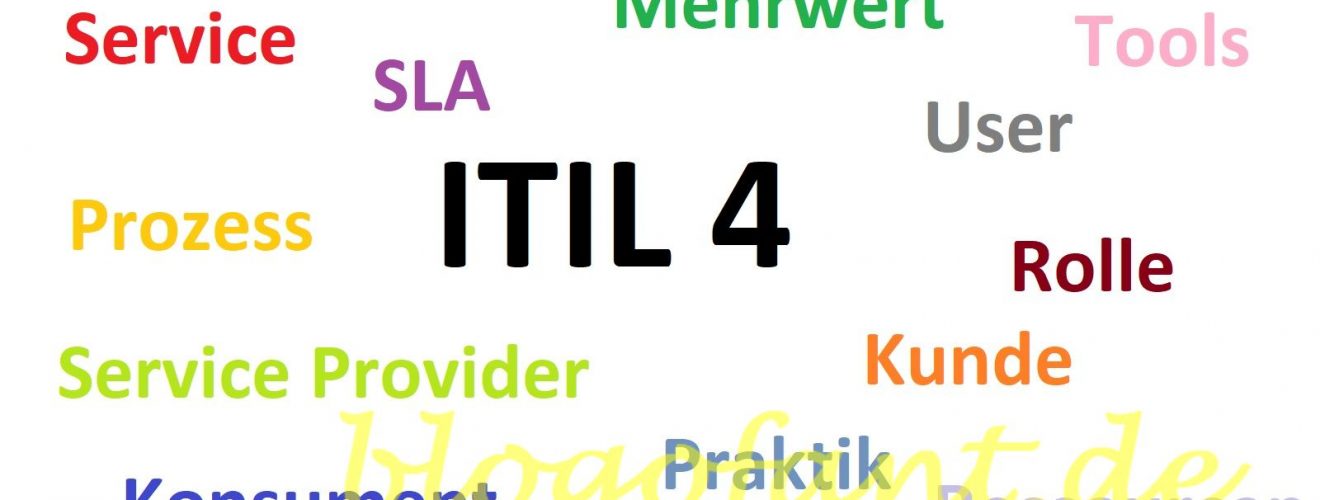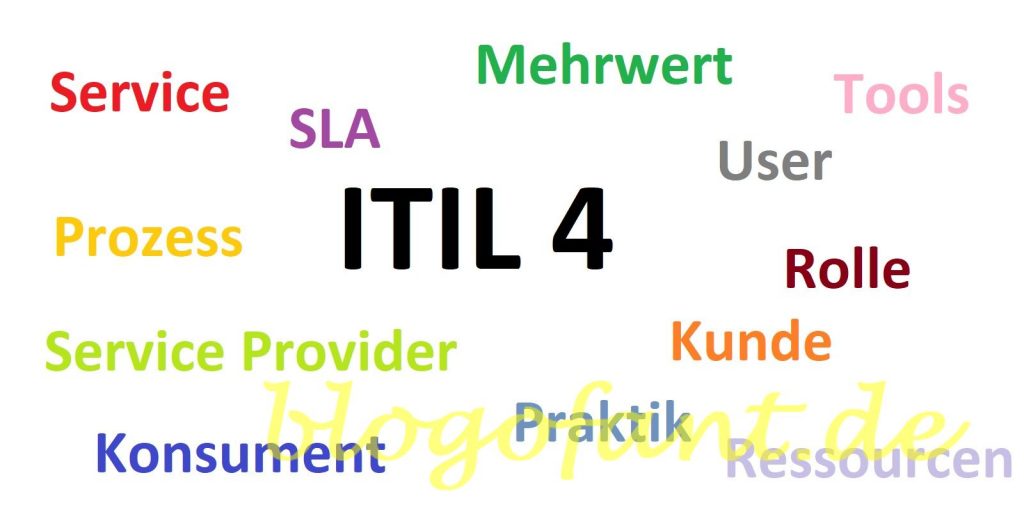Learning ITIL 4 – summary, examples, questions, answers

What is ITIL 4?
ITIL has been a proper name since version 4. However, ITIL used to stand for Information Technology Infrastructure Library. ITIL 4 is largely based on ITIL 3, whereby ITIL 3 is still valid. In February 2019 ITIL 4 appeared, which is a concept for best practice – i.e. a recommendation. However, ITIL is not a standard nor is it a norm. In addition, ITIL is completely manufacturer-neutral, which means that various tools can be used. Due to the concept of best practice, ITIL must be tailored and adapted to each company (customizing). The aim of ITIL is therefore “good practice” and added value for the customer. As in every process area, there are predefined keywords – their own wording – with definitions on which ITIL is based.
The ITIL certifications
Only people can be ITIL certified – not companies. ITIL is a living culture that can only be achieved by people and teams who live the processes and organizations with good structures. The aim is to support the customer with a service in his business processes and thus to create value (added value) for the customer.
People who are already ITIL 3 certified can switch to ITIL 4 under certain circumstances. With an ITIL 4 Foundation (basic / basic certificate), ITIL 3 certificates can be obtained in addition to ITIL 4.
Current Posts
- 10 ways to wish Spaniards a happy birthdayWerbung / Advertisements Birthdays in Spain are celebrated with much warmth and joy, reflecting the country’s vibrant culture and deep-rooted traditions. Understanding the Spanish way of celebrating can turn a simple birthday wish into...
- 10 ways to wish Swiss people a happy birthdayWerbung / Advertisements Switzerland, with its rich tapestry of cultures and languages, offers a unique blend of traditions, especially when it comes to celebrating birthdays. Understanding the cultural nuances behind birthday wishes can transform...
- Navigating Kotor: Tips and Tricks for First-Time VisitorsWelcome to Kotor Werbung / Advertisements Nestled along the Adriatic coast, Kotor, Montenegro, is a picturesque city that beckons travelers with its blend of historic charm, breathtaking landscapes, and rich cultural heritage. A UNESCO...
Documentation and logging
ITIL documents and logs every request from customers and every step. The documentation must be complete and in most cases during the activity. In exceptional cases, certain activities can be documented afterwards. In addition, everything is always archived in ITIL and never deleted. Archiving is necessary so that the right decision can be made.
Tools in ITIL?
A variety of tools are used in ITIL that analyze and simplify processes and help with activities and the services offered. Since ITIL is manufacturer-neutral, no definitive tools are mentioned. Tools often have to be adapted or are specific to the respective company. Nevertheless, there are some tools (generic terms) that are necessary:
- calendar
- Flip charts
- Wiki
- Ticket system
- Database system
It is important that all of these tools offer interfaces so that they can be linked to one another. Tools are primarily intended to support business operations and the services offered.

Wording
ITIL has its own wording. The terms are thus standardized and defined uniformly. It is necessary that every ITIL user refers to the same vocabulary when using it and understands the same thing behind it. Uniform wording is therefore necessary and normal. Companies also often use their own wording to talk about the same process, the same application or the same definition in certain areas.
The following technical terms are defined below:
- service
- Customer and consumer
- User / user / user
- Service provider
- Practice and Process
A service supports the business process or the activity of the customer so that the customer receives a result and a value (added value, value for customers) can be generated. The customer has added value from the result of the service. Practices, processes, roles, products, resources and assets are required for a service to be offered. The goal of a service should therefore be provision so that the customer can generate value.
The customer uses a service and pays a sum of money for this use. This requires an agreement with the customer (SLA – Service Level Agreement). In addition to the description and costs, this also includes what users are allowed to do.
A consumer, on the other hand, is anyone who uses a service. Consumers consume a service. The consumer can be a customer, a user or both in one.
The users (users, users) only use the service, but have nothing to do with the legal part of the service provider. This means that users don’t know the contracts, costs or agreements. A user therefore always belongs to a customer.
The service provider (the company that offers services) is in contact with the customer. The service provider is the organization that provides a service. All processes and practices that ITIL is about always relate to the service provider. The service provider has a contract (SLA) with the customer for the use of the service – the actual users are, however, the users.
A practice involves multiple processes, roles, resources, activities, and tools.
A process is therefore only part of a practice.
Example for customer, user, value, function and guarantee
Let us assume the trams of a transport company. Here the output is the tram, while the result (the outcome for the customer) is the journey from A to B. This is a service for which the customer (who is also a user / user here) pays. The service thus offers added value for the passenger.
The added value for the customer is determined by two factors: function and guarantee. Both of these are absolutely necessary for the service to offer value to the customer.
At the same time, there are also other components that are taken into account from the customer’s point of view – but not from the point of view of the service provider (a real drawback for ITIL). This is the risk and the cost to the customer – both ways. What do you mean with that? Let’s look at the cost first. There are costs for the ticket from A to B. On the other hand, a taxi ride would cost more, which can save costs. Even if free alternatives were chosen, time would determine the cost component. The same applies to the risk: pedestrians cannot stand in traffic jams or be blocked by track packers, but trams can. This increases the risk. At the same time, however, the risk also decreases if, for example, you are thinking of a bike ride that takes you on a busy road without a cycle lane.
ITIL at a glance
Do you want to learn more about ITIL? Don’t just understand the simple basic terms? Then it’s best to take a look at the ITIL overview page. All articles about ITIL are listed there. You should still start with the basic course on ITIL, as the wording is explained here. Then you can take a look at some practices – for example the help desk, incident and problem management or service request management.
ITIL 4 FAQ
Can companies be ITIL certified?
ITIL certified only employees – not companies. Even if all employees were ITIL certified, the company would not achieve this certification. The reason why companies should hire people with ITIL certification lies in the way they work and process thinking. Every service (product) should offer value to the customer. In addition, the way ITIL works creates a certain structure, documentation and logging.
More about ITIL 4
If you want to know more about ITIL, I recommend buying a course or a book. If you just want to get to know the practices of ITIL or want to find out whether ITIL is interesting, you should reach for an ITIL book. However, anyone striving for certification needs a course – and it’s worth it.











